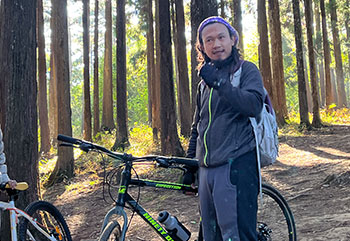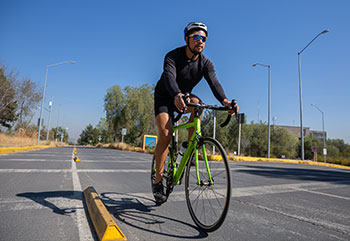Road Bikes vs. MTB’s – What’s the Difference

If you were to place an MTB and a Road bike one beside the other, you would find them almost the same as each other at a casual glance. You have two wheels connected with a frame that sports a seat on one side and leads to the handlebar on the other side. You have a bicycle chain that runs from the front wheel to the rear wheel, and you may not have a derailleur depending on your it is or not a geared bike.

What makes the bikes different are their components that will be unique to each of their riding style and terrain.
A road cycle is meant for riding on paved surfaces. It's all about speed. On the other hand, the MTB is built to withstand rough terrain and traverse uneven roads, off-roads, and trails.
The terrain and use of the bike make the Road bike and the MTB unique and distinct from each other. Let's explore these individual components
1) Tyres

One can easily guess that the tyres for these two bicycles will be different and distinct since they are used for completely opposite types of riding surfaces. And the tyres are the only contact that your bicycle has to the riding surface. Tyres grip the surface they move on. But for a road bike, the surface is smooth, and since the bike, unlike motorized vehicles, does not travel at high speeds, you find that the treads are very light or non-existent.
But on the other hand, an MTB is used in off-road conditions, and there is a need for the tyres to dig in and grip the loose, maybe wet gravel and sand. So you would find deep treads for Mountain bike tyres.
Another thing that changes would be the tyre pressure required in Road bikes vs an MTB.Lower pressure is what an MTB would need to better grip or be hi-traction, unlike a road bike where a firm but thin tyre well inflated does not flatten on an asphalt surface. This ensures less surface area in contact with the road allowing it more speed and less friction.
The width of a Road bike tyre is mostly below 2" vs an MTB which would be 2" and above. Less tread, thinner contact patch, and higher pressures generally mean the Road bike tyres will roll faster, which is exactly what is needed.
2) Handlebars

Think about the scene of a bicycle race like the Tour de France and think about the rider's positions while cycling. They are bent forward, in a more horizontal position. This position allows more aerodynamics allowing the rider to bike at greater speeds, and since it lowers the center of gravity, it helps in cornering at fast speeds. The drop handles allow the rider to change from about three to five hand positions. This is a great versatility especially required for long races and provides relief to the rider.
On the other hand, MTB's use wide and flat handlebars, which offer the rider a single hand position and a comfortable upright riding position. The wide handle of the flat bar makes it easier to balance and maneuver on bumpy roads.
3) Suspensions
A bicycle's suspensions let the wheels move up and down so that they can absorb the shock from small bumps while ensuring that the tyres are in contact with the ground for better control.
For an MTB having great suspensions will be of utmost importance. So most mountain bikes sport suspensions. There are rigid MTBs with no suspensions, but a hardtail with front-only suspensions is more common than full with both front and rear suspension. It all depends on the terrain you ride, the more rugged, the more suspension is preferable.

Since road bikes are used on well-paved surfaces, there is no need, and they usually do not have suspensions. There are, however, some high-end Road bikes that offer a small amount of suspension.
4) Wheel Size
You will notice Road bikes wheels mentioned as 700c, where 700 is the diameter in mm that is approximately equal to 28 inches. The MTBs are primarily available in27.5," and 29". Essentially bigger diameter wheels roll more efficiently whilst smaller diameter wheels provide better handling. The tyre's width is also important. Simply put, the wider it is, the more it soaks up bumps, but the less efficiently it rolls.
5) Frame
The frames of an MTB and a Road bike are more or less similar. There are minor variations to give the MTB rider an upright riding position, perfect for handling unpaved terrain. The frame of a Road bike, on the other hand, is designed to give the rider a more stretched out and horizontal riding position which improves efficiency and aerodynamics

6) Weight of the bicycle
On average, a Road bicycle is considerably lighter than an MTB. Road bikes are made from the lightweight material, have thinner wheels and tyres. An MTB is designed to be sturdier with wider wheels and tyres and may be made from steel or carbon steel.
Now that you are aware of the distinct differences between a Road Bike and MTB components, you can make a more educated choice when choosing your own bicycle. Do visit Ninety One online to select from the highly-rated MTBs and Road Bikes.
What are your thoughts on the differences between a Road Bike and an MTB? Please share by adding to the comments box below.
Related Blogs

Cycling Guides
Confused Between Road, City & Hybrid Bikes? We Are Here To HelpWhen it comes to investing in the right bicycle, it’s essential to understand the specifications of road bikes, city bikes, and hybrid bikes. Read on to know all about what differentiates these three bike types.

Cycling Guides
Road Bicycles: A Complete Guide On Understanding ThemWe see lots of road bicycles now but how much do we really know about this popular cycle category? Here’s all you need to know about them.

Cycling Tips
Cycling Checklist for BeginnersA comprehensive list of things that novice cyclists should know to make their rides enjoyable experiences

